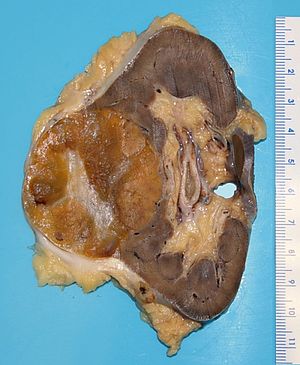Gross pathology
Jump to navigation
Jump to search


A kidney tumour (renal oncocytoma) at the time of grossing.
Gross pathology, also simply gross, refers to the macroscopic pathology, and the macroscopic assessment of pathology specimens. It may include preparation of tissue for a microscopic examination. It is an essential part of pathologic assessments.
The process of cutting up specimens is known as grossing (North American term), cut-up or macroscopic cut-up (Australian term).
Specimen opening
- Usually referred to simply as opening.
- May go by the term freshing.
- The first part of a gross pathologic assessment.
Components
- Orient the specimen.
- Paint with ink - if applicable.
- A good general rule is: ink before you think.
- Cut open for fixation - if not immediately blocked.
Gross only
Which specimens are "gross only" typically depends on institutional policy.[1]
Common gross only specimens
- Teeth.
- Foreign bodies.
- Femoral head with osteoarthritis - no fracture & no history of cancer.
- Calcific aortic stenosis.
Gross spot diagnosis
Heart
- Infective endocarditis.
- Bicuspid aortic valve.
- Nonbacterial thrombotic endocarditis - non-distructive.
- Rheumatic heart disease - fish mouth valve, thick cordae tendinae.
- Calcific aortic stenosis.
Heart - other:
- Fibrinous pericarditis.
- Hypertrophic cardiomyopathy - septal thickness > free wall thickness.
- Cardiac hypertrophy.
- Dilated cardiomyopathy.
- Arrhythmogenic right ventricular cardiomyopathy.
- Atrial septal defect.
- Ventricular septal defect.
- Patent foramen ovale.
Cardiovascular
- Aortic dissection.
- Aortic rupture.
- Cerebral saccular aneurysm.
Lungs
- Pulmonary thromboembolism.
- Pulmonary infarct.
- Lung abscess.
- Lung tumour (primary).
- Metatstatic tumour lung - usu. multiple and peripheral.
- Malignant mesothelioma.
- Pleural plaques.
- Emphysema.
- Pneumothorax.
- Hemothorax.
- Hypoplasia secondary to diaphragmatic hernia.
Gastrointestinal pathology
- Squamous cell carcinoma of the esophagus - classically mid esophagus.
- Adenocarcinoma of the esophagus - usually distal esophagus.
- Barrett's esophagus.
- Esophageal varices.
- Esophageal perforation.
Stomach:
- Malignant gastric ulcer.
- Peptic ulcer.
- Gastric antral vascular ectasia.
- Leopard spots - seen in hypothermia.
- GIST.
- Peptic ulcer.
- Duodenal adenocarcinoma - classically assoc. with FAP.
- Cirrhosis.
- Hydatid cyst.
- Hepatocellular carcinoma - in the context of cirrhosis.
- Metastases.
- Hemangioma.
- Focal nodular hyperplasia.
- Hepatic adenoma.
- Cholangiocarcinoma.
- Congestive hepatopathy (nutmeg liver) - seen in congestive heart failure.
- Hepatic infarct - classically at the periphery, red and wedge-shaped.
- Cholelithiasis.
- Cholesterolosis of the gallbladder.
- Gallbladder polyp.
- Solid pseudopapillary neoplasm - with age & sex provided.
- Pancreatic adenocarcinoma.
- Neuroendocrine tumour.
- Chronic pancreatitis.
- Ischemic small bowel.
- Meckel's diverticulum.
- Intussusception.
- Neuroendocrine tumour - if on section.
- GIST.
- Incarcerated hernia.
Large bowel:
- Colorectal adenocarcinoma.
- Bowel infarction.
- Ulcerative colitis - no skip lesions, no wall thickening.
- Crohn's disease - creeping fat, cobble stone pattern, skip lesions, fistulas.
- Pseudomembranous colitis.
Gynecologic pathology
Ovary:
- Mucinous tumour.
- Mature teratoma.
- Serous cystadenoma of the ovary.
- Fibroma.
- Brenner tumour - may be yellow, typically solid.
- Endometrioma.
Uterine tube:
- Ectopic pregnancy.
- Tubal abscess.
- Adenomatoid tumour.
Uterus:
- Adenomyosis.
- Leiomyoma - multiple.
- Endometrial carcinoma.
- Leiomyosarcoma - friable, solitary, fish flesh.
- Bicornuate uterus.
- Uterus didelphys.
- Sarcoma botryoides (embryonal rhabdomyosarcoma).
Uterine cervix:
- Nabothian cyst.
- Cervical polyp.
- Cervical carcinoma.
Dermatopathology
Tumour:
Possible syndromic:
- Seborrheic keratosis - Leser–Trélat sign
- Neurofibroma - neurofibromatosis.
- Angiofibroma - Fabry disease.
Neuropathology
Bleeds:
- Epidural hematoma
- Subdural hematoma.
- Subarachnoid hematoma - berry aneurysm.
- Intracerebral hematoma - hypertensive, usu. thalamus.
- Lobar hemorrhage - periphery of cortex.
- Duret hemorrhage - pontine hemorrhage.
Tumours:
- Meningioma - intradural, extramedullary.
- Glioma.
- Schwannoma - cerebellopontine angle.
- Myxopapillary ependymoma - filum terminale.
Non-tumour:
- Diffuse axonal injury - classically corpus callosum.
- Fat embolism.
- Cerebral contusion.
- Cerebral infarction - classically MCA territory.
Neurodegenerative:
- Alzheimer disease - atrophy spares occipital lobe.
- Frontotemporal dementia.
- Huntington disease - young, caudate nucleus missing.
Genitourinary pathology
Kidney:
- Clear cell renal cell carcinoma - yellow.
- Papillary renal cell carcinoma - friable.
- Chromophobe renal cell carcinoma - brown +/-hemorrhage, no central scar.
- Renal oncocytoma - brown, central scar.
- Autosomal dominant polycystic kidney disease.
- Angiomyolipoma - fat.
Testis:
- Seminoma - solid.
- Mixed germ cell tumour - cystic (often teratoma) & solid.[2]
- Leydig cell tumour - brown.
- Testicular torsion.
Paratesticular:
Placenta
Membranes:
- Marginal inserion - normal.
- Circumvallate placenta.
- Circummarginate placenta.
Disc:
- Retroplacental blood clot - suggestive of placental abruption.
- Chorangioma - big red intraparenchymal.
- Placental infarct - white = old, red = recent.
- Twin-to-twin transfusion syndrome - one side beefy red the other pale.
- Meconium staining/chorioamnionitis.
- Amnion nodosum.
- Squamous metaplasia of the amnion.
- Succenturiate placenta (placenta with accessory lobe(s)).
- Bilobate placenta.
Cord:
- Two vessel umbilical cord.
- False knot.
- True knot.
- Membranous insertion (AKA velamentous insertion).
- Furcate insertion - vessels separate before inserting.
Fetal
- Amniotic rupture sequence - includes amniotic band syndrome.
- Twin-to-twin transfusion syndrome (TTTS).
Genetic:
See also
- Basics.
- EIT.
- Tissue loss.
References
- ↑ Zarbo, RJ.; Nakhleh, RE. (Feb 1999). "Surgical pathology specimens for gross examination only and exempt from submission: a College of American Pathologists Q-Probes study of current policies in 413 institutions.". Arch Pathol Lab Med 123 (2): 133-9. doi:10.1043/0003-9985(1999)1230133:SPSFGE2.0.CO;2. PMID 10050786.
- ↑ Rose, Alan G. (2008). Atlas of Gross Pathology with Histologic Correlation (1st ed.). Cambridge University Press. pp. 447. ISBN 978-0521868792.